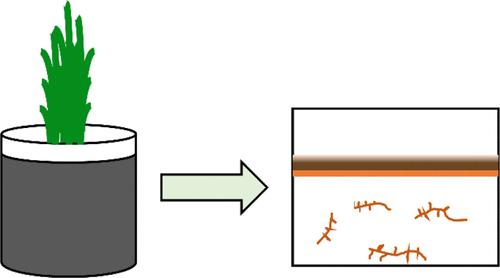当前位置:
X-MOL 学术
›
Environ. Sci. Technol.
›
论文详情
Our official English website, www.x-mol.net, welcomes your
feedback! (Note: you will need to create a separate account there.)
A New Method to Capture the Spatial and Temporal Heterogeneity of Aquatic Plant Iron Root Plaque In Situ
Environmental Science & Technology ( IF 10.8 ) Pub Date : 2020-12-30 , DOI: 10.1021/acs.est.0c02949 Matt A. Limmer 1 , Abby E. Evans 1 , Angelia L. Seyfferth 1
Environmental Science & Technology ( IF 10.8 ) Pub Date : 2020-12-30 , DOI: 10.1021/acs.est.0c02949 Matt A. Limmer 1 , Abby E. Evans 1 , Angelia L. Seyfferth 1
Affiliation

|
The roots of aquatic plants, including rice, release oxygen into the subsurface, precipitating reduced metals, such as iron (Fe) and manganese (Mn), as plaques that form on the surface of the roots. These plaques are a unique habitat for microorganisms and a hotspot for biogeochemical cycling, including the toxic trace metalloid arsenic (As). However, studying plaque deposition and mineral composition in this spatially and temporally heterogeneous environment is challenging, particularly in situ. Here, we describe a new technique for nondestructive and repeated rhizosphere sampling. We placed vinyl films that adhere Fe deposits from roots growing adjacent to the films into soil. The films were removed and replaced throughout plant growth and were characterized using a variety of spectroscopic (XRF imaging and Fe EXAFS) and microscopic (SEM and confocal) techniques. Fe deposits were most concentrated at lateral junctions and heterogeneity was apparent in the location and speciation of Fe-associated As in both pot and field studies. XRF imaging at multiple incident beam energies revealed that this As was mostly arsenate, although arsenite was present on the edge of the Fe deposit. Iron deposits were typically micron sized and consisted mostly of ferrihydrite, consistent with the data reported using conventional techniques. Moreover, Fe deposits were occupied by a variety of microorganisms. These films are a suitable technique to study a range of spatial and temporal questions regarding the biogeochemistry of aquatic plant roots.
中文翻译:

一种新的方法来捕获水生植物铁根斑块的时空异质性原位
包括水稻在内的水生植物的根部将氧气释放到地下,沉淀出还原性金属,例如铁(Fe)和锰(Mn),这些金属在根部表面形成斑块。这些斑块是微生物的独特栖息地,也是生物地球化学循环的热点,包括有毒的痕量准金属砷(As)。但是,在这种时空异质的环境中研究斑块沉积和矿物组成具有挑战性,特别是在原位。在这里,我们描述了一种用于非破坏性重复根际采样的新技术。我们放置了乙烯基薄膜,这些薄膜将铁沉积物附着在土壤附近,这些铁沉积物的生长根部与薄膜相邻。在整个植物生长过程中将膜去除并更换,并使用各种光谱学(XRF成像和Fe EXAFS)和显微镜(SEM和共聚焦)技术对其进行表征。在矿床和田间研究中,铁沉积物最集中在侧向交界处,并且在与铁有关的砷的位置和形态方面,异质性很明显。在多个入射光束能量下的XRF成像表明,尽管砷存在于铁矿床的边缘,但这种砷主要是砷。铁沉积物通常为微米大小,且主要由水铁矿组成,与使用常规技术报道的数据一致。此外,铁沉积物被多种微生物占据。这些电影是研究有关水生植物根的生物地球化学的一系列时空问题的合适技术。
更新日期:2021-01-19
中文翻译:

一种新的方法来捕获水生植物铁根斑块的时空异质性原位
包括水稻在内的水生植物的根部将氧气释放到地下,沉淀出还原性金属,例如铁(Fe)和锰(Mn),这些金属在根部表面形成斑块。这些斑块是微生物的独特栖息地,也是生物地球化学循环的热点,包括有毒的痕量准金属砷(As)。但是,在这种时空异质的环境中研究斑块沉积和矿物组成具有挑战性,特别是在原位。在这里,我们描述了一种用于非破坏性重复根际采样的新技术。我们放置了乙烯基薄膜,这些薄膜将铁沉积物附着在土壤附近,这些铁沉积物的生长根部与薄膜相邻。在整个植物生长过程中将膜去除并更换,并使用各种光谱学(XRF成像和Fe EXAFS)和显微镜(SEM和共聚焦)技术对其进行表征。在矿床和田间研究中,铁沉积物最集中在侧向交界处,并且在与铁有关的砷的位置和形态方面,异质性很明显。在多个入射光束能量下的XRF成像表明,尽管砷存在于铁矿床的边缘,但这种砷主要是砷。铁沉积物通常为微米大小,且主要由水铁矿组成,与使用常规技术报道的数据一致。此外,铁沉积物被多种微生物占据。这些电影是研究有关水生植物根的生物地球化学的一系列时空问题的合适技术。











































 京公网安备 11010802027423号
京公网安备 11010802027423号